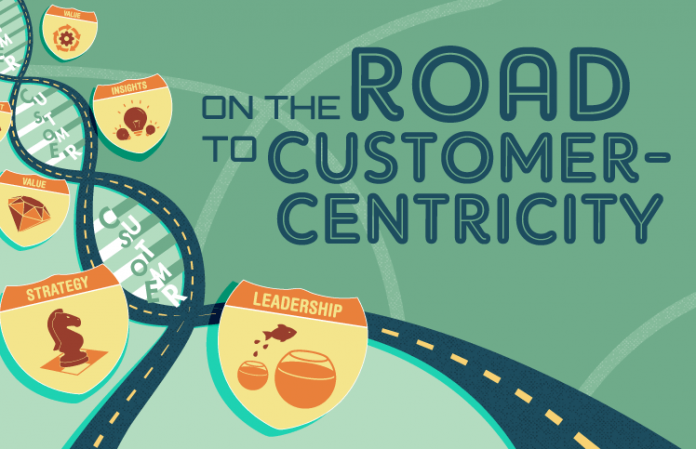
In recent years, a growing number of organizations have demonstrated progress toward becoming more customer-centric. For some, the transformation that began as conversations in the executive suite is now beginning to take root in the company culture and day-to-day practices on the front lines.
Yet, many more are still in the early stages of discovering that being customer-centric involves much more than simply advocating good service. Customer experience management expert Janet LeBlanc defines a customer-centric organization as one that has attained a level of maturity that allows it to respond to customers in the most appropriate ways: “They engage, train and mobilize their employees, who are aware of the correct behavior to meet customer needs and who know when and how to act according to the circumstances needed to keep customers satisfied,” she says. “Throughout every touchpoint of the customer-centric organization—whether it is directly or indirectly interfacing with the customer—there is a clear sense of purpose and discipline around how to improve and enhance the customer experience.”
The Road Behind: Gaps and Improvement Opportunities
As more organizations begin to make the move from talk to action, where do most lie on the customer experience maturity curve? Janet LeBlanc + Associates has been tracking the state of customer-centricity in North American companies since 2012. The consultancy’s biennial “North American Study on Customer-Centricity” evaluates 45 essential practices across five pillars of customer-centricity (listed below) necessary to consistently deliver a positive experience that creates value for both customers and the company.

LeBlanc’s summary of the 2014 findings exposed several key gaps and opportunities for improvement within each pillar:
Strategic Alignment. Despite the desire to strategically align the organization around the customer, less than 35% of participants reported directly linking their annual executive performance to customer experience improvements. Just over half (52%) of companies reported having a brand promise that reflects customer-centricity, and only 33% used performance management to track customer experience improvements.
Senior Leadership. Less than half of participating companies considered customer experience a recurring leadership agenda, and 63% did not consider company leaders to be customer-centric.
Customer Insights. Only 40% of respondents rated their organization’s ability to drive product development using evolving customer expectations as excellent; 44% ranked it as fair and 17% said it was poor. Less than one-third (28%) reported regularly tracking how customer-focused frontline employees behaved at all interaction points.
Employee Engagement. Only 38% ranked their company as excellent when it came to clearly communicating what customer-centricity means across the organization, and just 33% of respondents reported training employees to deliver a consistent experience across interaction channels.
Measurement and Rewards. Just over one-third (35%) of participants rated their company as excellent at rewarding and recognizing the achievement of customer experience improvements, and only 30% believed that the company did an excellent job of tracking the effectiveness of customer experience action plans and initiatives.
Recent Progress, But Still Much Room to Improve
The results from the most recent study on customer-centricity have not yet been released, but an early look at the findings reveals progress across all five pillars, LeBlanc says. (Look for her article on the most recent study results in the March 2017 issue of Pipeline).
Senior Leadership, in particular, has made considerable headway over the years. In 2012, leaders were focused primarily on gathering customer insights through market research and by tracking customer satisfaction. “In 2014, senior leaders showed progress in terms of understanding their role and the need to strategically align the organization around the concept of customer-centricity,” LeBlanc says. “But to truly embrace customer-centricity, everyone in the organization—whether you’re on the front line or in a back-office function—needs to understand their role in delivering the ideal customer experience. It’s the end-to-end journey that impacts the customer’s perception of the overall experience.”
It seems that message is being heard by more executives. The 2016 survey showed that 45% of participants rated their senior leadership as excellent at modeling and leading customer-centric behaviors, compared to 37% in 2014.
Organizations are slowly gaining some ground in the Employee Engagement pillar. In 2012, organizations, overall, received a failing grade (5.2 out of 10) when it came to clearly defining and communicating to employees what they need to do to improve the customer experience. That score rose one point in 2016, LeBlanc says, adding that “there is still a lot of work to do in that area, but it’s moving in the right direction.”
Measurement and Rewards is the area that organizations are struggling the most with, LeBlanc says. “Measurement and rewards are about shaping behaviors—particularly, tracking the effectiveness of customer experience action plans and improvements, and using that information to recognize changes in behavior,” she stresses. “Most of the time, organizations are racing around trying to fix pain points in the customer experience. They don’t stop to measure and recognize the improvements in customer experience—in terms of how customers perceive that interaction but also within internal operational metrics.
“Yet, doing so significantly accelerates the pace of transformational change,” she adds. “Management and employees want to know that they’re doing the right thing and that they’re doing well. Seeing the successes along the way motivates everyone, and creates a sense of excitement that the organization is on track. Building a customer-centric culture is a long journey, and we all want to know that the things we’re putting in place are having an impact.”
To learn more about the five pillars, join Janet LeBlanc’s webinar on “The Five Building Blocks of Customer Centricity,” on Jan. 24, 2017, 3 p.m. EST (produced by The Conference Board of Canada).




